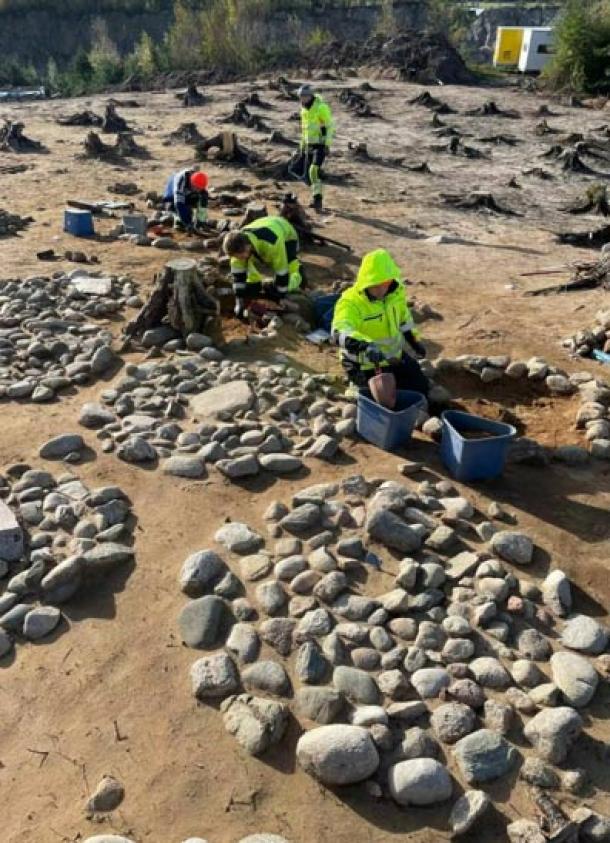An ancient burial field in Norway that features more than 40 circular stone grave markers has been found to contain the remains of mostly children, all of whom died more than 2,000 years ago, Norway’s Museum of Cultural History reports.
The partially burnt bones of the children, who ranged in age from infancy to six years old at the time of death, were buried directly beneath the curious stone circles, in finely-crafted ceramic pots that long ago shattered into pieces. Dating of the skeletal remains revealed the children had almost all been buried between 800 and 400 BC, or during Norway’s Bronze Age and Iron Age.
“The dating shows that the burial site was used over a long period, so they couldn’t all have died in the same natural disaster or outbreak of disease or epidemic,” site excavation leader Guro Fossum, an archaeologist affiliated with the Museum of Cultural History, told the Norwegian news service NTB.

The children’s graves date from the transition between the Bronze and Iron Ages, with most of them buried between 800 and 400 years BC. (Museum of Cultural History)
A Child’s Graveyard, Made and Maintained with Loving Care in 800 BC
The meticulously constructed stone circles were discovered during excavations of a rural field near the city of Fredrickstad in southern Norway in 2023. They were hidden just 2-4 inches (5-10 centimeters) below the earth’s surface, in an area adjacent to a Stone Age settlement that was the original site being explored.
The stone formations were all between three and six feet (one and two meters) in diameter and were either perfectly round or oval-shaped. Some had larger stones placed in the middle or on their edges, signaling some diversity or creativity in the designs.
As luck would have it, one of the stone circles had been exposed by erosion and the passage of time. When the archaeologists excavating the Stone Age settlement discovered it, they immediately shifted their focus to the area around the circle. They eventually unearthed 41 of these unusual stone formations in total, which were concentrated within a relatively small area, smaller than would normally be expected given their purpose.
While the circles and the assemblies of medium-sized stone they were made from had some distinctive characteristics, the archaeologists did have some context to work with in identifying them.
Classic Spiral Bronze Age Burials in Norway
In Norway’s Bronze Age and Pre-Roman Iron Age, it was common practice to cremate the deceased and to bury their remains in pits, which were then covered by a flat layer of stones. This layer was often made in the shape of a wheel or a spiral, consistent with what has been found at the freshly excavated site near Fredrickstad. So despite some of the unique features of the stone circles found here, the archaeologists tentatively identified them as grave markers even before the soil beneath them had been broken open.
“They’ve lain here as a secret until we found them,” Fossum said. “We uncovered one after another and ended up with 41 round stone formations.”
Once the circles had all been unearthed and their contents revealed, their discoverers realized they had stumbled across something special.
“The graves are very close together,” Fossum explained. “They must have been in an open landscape with thoroughfares nearby, so everyone would have known about them. Cooking pits and fireplaces around the site suggest that gatherings and ceremonies were held in connection with burials.”
The Norwegian archaeologist noted that the grave markers or monuments were precisely designed and arranged and also well-maintained. They were made from stones taken from a variety of locations in the area, presumably to ensure they would be uniform in size and shape.
After excavating the buried skeletal remains and completing their study of them in their laboratories, Fossum and her team understood the characteristics and condition of the grave markers much better.
“When the analysis results came in it made sense: they were small children’s graves,” she said. “[That’s why] this was done with so much care.”
The Mysteries of Ancient Cultures are Revealed … Sometimes
One notable characteristic of the newly unearthed graveyard is that everyone who was buried there, which did include some men and women in addition to the children, was treated as an equal at the time of their death.
“It seems that the social structure was more egalitarian, as there wasn’t much difference between the graves,” Fossum stated. “The same type of graves, grave goods, and burial method were used. This suggests a society where community was important.”
The next step for the Museum of Cultural History archaeologists will be to study the pottery pieces recovered from the graves more closely, to see what might be revealed about the ancient society that manufactured these items.
“Analyses of the pottery fragments can tell us a lot,” Fossum said. “It doesn’t appear that all the vessels were containers for burnt bones; some were placed between the graves, and we are very curious about what was inside them.”
Regardless of what further analysis of the grave goods, the skeletons of the children, and the stone circles might disclose, a good deal of mystery about the culture responsible for all of them will persist.
“We don’t know what kind of beliefs they had, why the dead were burned and buried,” Fossum said. “It’s possible that they believed the body had to be destroyed and transformed through fire to release the soul. Maybe these traditions and rituals were meant to honor and remember those who had died. We do the same now: we remember those who lived before us with rituals and memorials.”
All of this is speculative, the archaeologist admits, and likely will remain so going forward.
Top image: Archaeologists at work in a large burial field in southeastern Norway, where 40 circular stone formations with cremated bone remains, mostly from children, were found placed in the middle. Source: Museum of Cultural History/Science Norway






